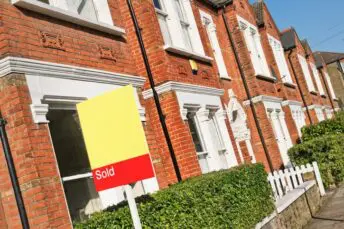House Price Watch Sept 2022
In spite of growing economic uncertainty, house prices remain firm. However, there are signs the housing market is slowing with softening buyer demand and declining mortgage activity for house purchases. Given increases in the cost of living, higher mortgage rates and stretched affordability, we expect buyer demand to continue to fall in the months ahead. In the near term, house prices will remain underpinned by a shortage of homes for sale, though the rate of price growth will continue to slow in the last quarter of the year.
What’s happening nationally
House prices are up on average +0.3% in the past month and +11.0% in the past year.
While the average monthly and annual house price indices continue to show a rise in house prices, it is important to look at individual indices to see emerging trends. Both Nationwide and Halifax, tracking mortgage applications for house purchase in September show steady or falling house prices. Land Registry, reporting August figures reports higher growth rates and is pushing up the overall average.
Indices based on:
Land Registry – registered property transactions in August.
Nationwide & Halifax – mortgage valuations in September.
Rightmove – asking prices posted on Rightmove in September.
*Rightmove is not included in the index average as the basis for its index is different (asking price vs agreed sale price)
| Index reports: | Monthly change | Annual change |
|---|---|---|
| Land registry | +0.9% | +13.6% |
| Nationwide | +0% | +9.5% |
| Halifax | -0.1% | +9.9% |
| Rightmove | +0.7% | +8.7% |
| Average change | +0.3% | +11.0% |
House prices in your area
Most regions of the UK have seen house prices up over the past month and most areas have seen double digit house price growth over the past year.
Areas with the highest annual growth in house prices include: the South West (+17.0%), the East Midlands (+16.97%) and the North West (+15.3%).
Average house prices are highest in London (£553K) and lowest in the North East (£164K).
House price growth varies somewhat by property type. Detached homes have seen the biggest rise (+15.3%) and flats/ maisonettes the smallest (+10.1%) according to Land Registry data. This may reflect regional price differences (more flats in London), as well as, demand – higher demand for bigger properties and fewer properties of this type available for sale over the past year.
| UK Region | Average price £ | Monthly change | Annual change |
|---|---|---|---|
| England | |||
| Nothern Ireland | |||
| Scotland | |||
| Wales | |||
| North West | |||
| Yorkshire and The Humber | |||
| North East | |||
| West Midlands | |||
| East Midlands | |||
| South West | |||
| East of England | |||
| South East | |||
| London |
| UK City | Average price | Annual change |
|---|---|---|
Market Monitor
Transactions increased in August and are slightly higher than usual for this time of year.
There were 105K transactions in August up 1% on July 2022 and up 7.6% on August last year.
Demand continues to soften but new seller instructions also fall. Stock of homes for sale improves slightly.
Time to sell slightly slower but still faster than the 12 month average.
How busy is the market?
- Not busy
- Normal
- Very busy
- Transactions up month on month and slightly higher than is typical this time of year.
- Total transactions in August 104K
- +1.1% from last month
- +7.6% from August last year
Homes for sale vs homebuyers
- Good availability of homes
- Normal
- Shortage of homes
- Buyer enquiries continue to soften (-36% RICS); fifth monthly drop
- Seller enquiries down(-13% RICS)
- Average stock per agent 49; improving (incl under offer/ Sold STC Rightmove)
Average speed of sale
- Fast
- Normal
- Slow
- 35 days to find a buyer (12 month average 36 days Rightmove)
What the experts say
Rightmove

“Price growth this month is driven predominantly by the middle and high-end market sectors, the “second stepper” category. For those who can, moving up the ladder to a home with more space remains a priority, even at a time when personal finances are stretched. However, the rising cost of living is increasingly playing a role in some buyers’ considerations, as they look at their budgets and what they can afford. Demand has been softening over the last few months. The average monthly mortgage payment for new first-time buyers putting down a 10% deposit has now reached 40% of an average gross salary for the first time since November 2012. A 10% deposit on a first time buyer type home is now 57% higher than 10 years ago, while average salaries have increased by 32% over the same time, making it increasingly difficult to save the necessary deposit.”
Nationwide

“Further signs of a slowdown over the past month, with the number of mortgages approved for house purchase below pre-pandemic levels and surveyors reporting a decline in new buyer enquiries. Nevertheless, the slowdown to date has been modest and, combined with a shortage of stock, has meant price growth has remained firm. The reduction in stamp duty may provide some support to activity and prices, as will the strength of the labour market. However, headwinds are growing stronger suggesting the market will slow in the months ahead. High inflation is exerting significant pressure on household budgets. Housing affordability is more stretched. Deposit requirements remain a major barrier, with a 10% deposit on a typical first-time buyer property equivalent to 60% of annual gross earnings – an all-time high. Moreover, the significant increase in prices in recent years together with the significant increase in mortgage rates since the start of the year have pushed the typical mortgage payment as a share of take-home pay well above the long-run average.”
Halifax

“The events of the last few weeks have led to greater economic uncertainty, however in reality house prices have been largely flat since June, suggesting the housing market may have already entered a more sustained period of slower growth. Predicting what happens next means making sense of the many variables now at play, and the housing market has consistently defied expectations in recent times. While stamp duty cuts, the short supply of homes for sale and a strong labour market all support house prices, the prospect of interest rates continuing to rise sharply amid the cost of living squeeze, plus the impact in recent weeks of higher mortgage borrowing costs on affordability, are likely to exert more significant downward pressure on house prices in the months ahead.”
Zoopla (Hometrack)

“The Housing market is transitioning to a buyers’ market as higher mortgage rates are set to cut buying power by up to 28%. The jump in house prices over the pandemic is compounding the affordability challenge, especially in southern England. Stamp duty changes are welcome and will boost some sectors of the market but, overall, they are unlikely to offset the impact of higher mortgage rates on housing activity.”
RICS

“The September 2022 RICS UK Residential Survey results remain indicative of the sales market losing momentum, with the outlook for interest rates and the uncertain macro picture more broadly taking a toll on activity. Indeed, at least in terms of the initial reaction, the impact from the expected rise in mortgage rates over the coming six months is anticipated to outweigh any potential boost from the recently announced cut to Stamp Duty. For the time being, house prices are still edging higher across the country, underpinned by the lack of stock available. Nevertheless, the pace of growth has moderated noticeably according to the latest survey feedback.”




